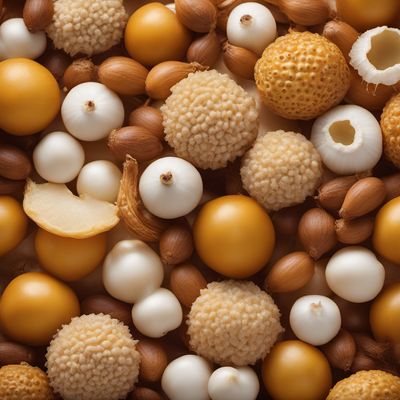
Ingredient
Papayas and similar-
The Tropical Delight
Papayas and similar fruits are large, oval-shaped fruits with a smooth, greenish-yellow skin and a vibrant orange flesh. They have a sweet, tropical taste with a hint of muskiness and a soft, buttery texture. These fruits are known for their high water content and are often used in salads, smoothies, salsas, and desserts.
Origins and history
Papayas are believed to have originated in Central America and Southern Mexico. They have a long history of cultivation and have been enjoyed for centuries by indigenous communities. Today, they are grown in tropical regions around the world, including countries like India, Brazil, and Thailand. Papayas hold cultural significance in many countries and are often used in traditional dishes and remedies.
Nutritional information
Papayas are a rich source of vitamin C, vitamin A, folate, and dietary fiber. They are low in calories and fat, making them a healthy addition to any diet. Additionally, papayas contain an enzyme called papain, which aids in digestion and has anti-inflammatory properties.
Allergens
Papayas and similar fruits may cause allergic reactions in individuals with latex allergies. These fruits contain proteins that are similar to those found in latex, which can trigger an allergic response in sensitive individuals.
How to select
When selecting papayas and similar fruits, look for ones that are slightly soft to the touch and have a vibrant, yellowish-orange color. Avoid fruits with bruises, blemishes, or overly soft spots. The skin should be smooth and free from wrinkles. Additionally, the fruit should have a pleasant, sweet aroma.
Storage recommendations
To store papayas and similar fruits, keep them at room temperature until they are fully ripe. Once ripe, they can be stored in the refrigerator for up to a week. Cut papayas should be wrapped tightly in plastic wrap and refrigerated. Avoid storing unripe papayas in the refrigerator, as they may not ripen properly.
How to produce
Papayas and similar fruits can be grown in tropical or subtropical regions. They require a warm climate, well-drained soil, and plenty of sunlight. They can be grown from seeds or propagated through cuttings. Regular watering and fertilization are essential for healthy growth.
Preparation tips
Papayas and similar fruits can be enjoyed fresh, sliced and added to fruit salads, smoothies, or yogurt bowls. They can also be used in savory dishes like salsas, chutneys, and stir-fries. Additionally, papayas can be blended into refreshing beverages or used as a topping for desserts like ice cream or cheesecake.
Substitutions
Papayas can be substituted with mangoes or peaches in recipes that call for a tropical fruit with a similar texture and flavor. However, keep in mind that the taste may vary slightly.
Culinary uses
Papayas and similar fruits are commonly used in tropical and Caribbean cuisines. They are often incorporated into dishes like papaya salad, papaya boats filled with seafood or chicken, and papaya-based sauces or dressings. They are also popular in desserts like papaya pudding or papaya sorbet.
Availability
Papayas and similar fruits are commonly available in tropical regions around the world. They are cultivated in countries like India, Brazil, Mexico, Thailand, and the Philippines.
More ingredients from this category

Akee apples
The Tropical Delicacy

Langsats
The Exotic Delight: Langsats

Feijoas
The Exotic Gem of South America

Papayas
The Tropical Delight: Papayas

Tamarillos
The Exotic Tang of Tamarillos

Naranjillas
The Exotic Citrus: Naranjillas

Paw paws
The Exotic Delight

Mangosteens
The Exotic Jewel of Tropical Fruits